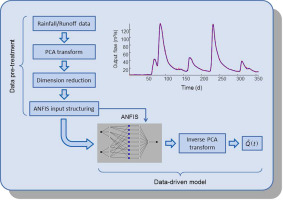Environmental Modelling & Software ( IF 4.8 ) Pub Date : 2017-12-06 , DOI: 10.1016/j.envsoft.2017.11.026 N. Bartoletti , F. Casagli , S. Marsili-Libelli , A. Nardi , L. Palandri

|
The development of rainfall/runoff models involves extensive computation and the availability of different coexisting platforms, including numerical flow models and GIS for their physiographical characterization. In this paper we present a data-driven approach which avoids the use of GIS, but is based on a combination of Principal Component Analysis (PCA) and an Adaptive Neuro Fuzzy Inference System (ANFIS) to produce a simple and effective output flow prediction based on previous rainfall/runoff data in the catchment. The emphasis of the paper is on how to set-up an efficient data structure that produces a good output flow estimation. The PCA approach is compared to the Thiessen polygons method, requiring GIS, and we demonstrate that the former can produce a better ANFIS model, with less algorithmic complexity and improved accuracy. The combined PCA + ANFIS procedure is applied to two minor river basins in Tuscany, Italy, to demonstrate its effectiveness.
中文翻译:

基于神经模糊推理系统的数据驱动降雨/径流建模
降雨/径流模型的开发涉及大量计算和不同共存平台的可用性,包括数值流模型和用于地理特征的GIS。在本文中,我们提出了一种数据驱动的方法,该方法避免了使用GIS,而是基于主成分分析(PCA)和自适应神经模糊推理系统(ANFIS)的组合,以基于简单有效的输出流预测根据流域先前的降雨/径流数据。本文的重点是如何建立有效的数据结构,以产生良好的输出流量估算。将PCA方法与需要GIS的Thiessen多边形方法进行了比较,并且我们证明了前者可以产生更好的ANFIS模型,并且算法复杂度更低且准确性更高。











































 京公网安备 11010802027423号
京公网安备 11010802027423号